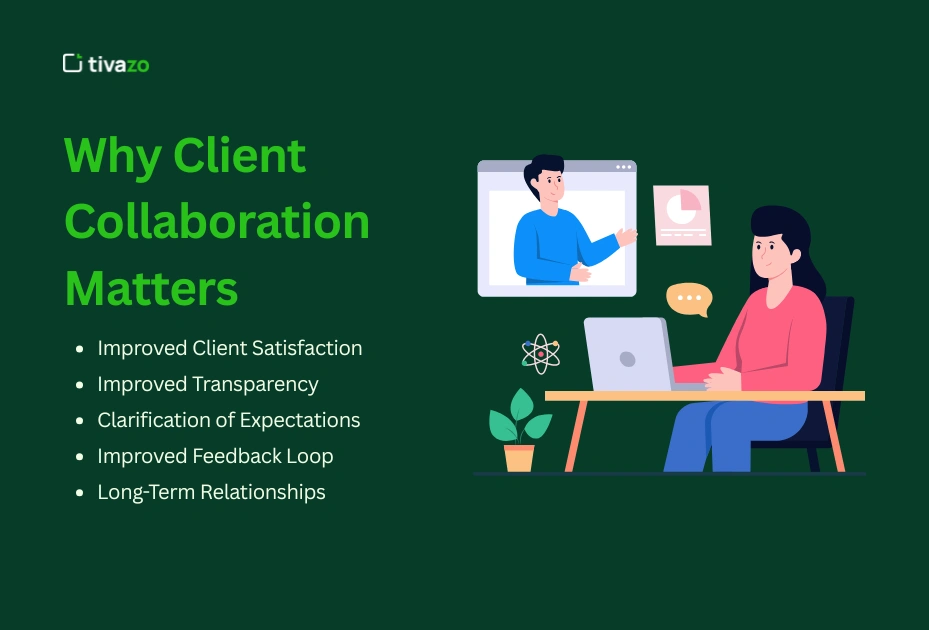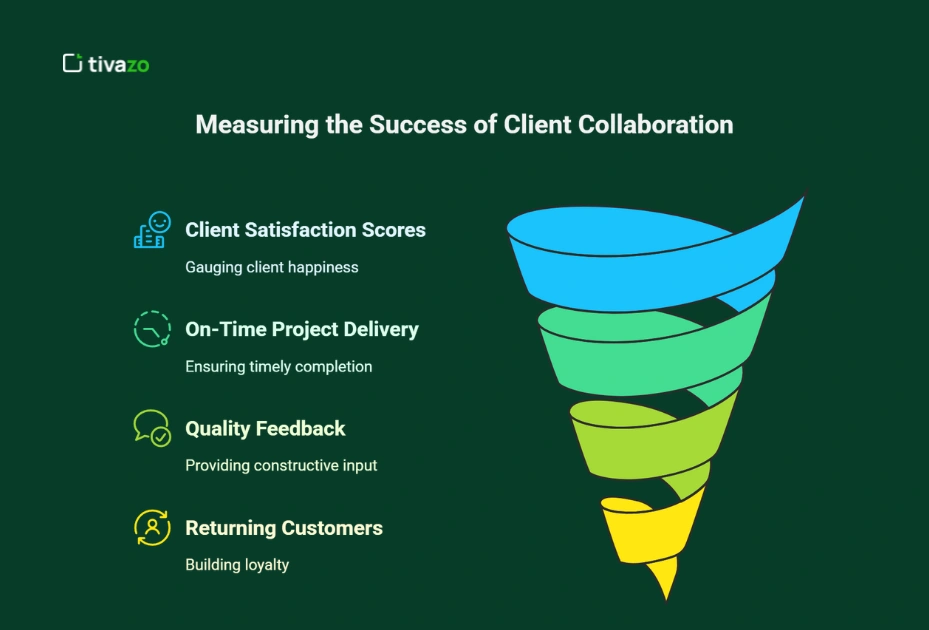Client collaboration is key to a strong business relationship and successful project delivery outcomes. Regardless of whether you have a micro, small, or medium business, or whether you are managing a single small project or a large project with many tasks, the way you engage and collaborate with your client will have a significant impact on your outcome. Essentially, collaboration builds trust, improves communication, increases synergies reducing wasted time, and can productively contribute to a path to a smooth project delivery. Importantly, strong client collaboration will contribute to achieving a more satisfactory project delivery outcome for your client or clients.
In this guide, you will learn in detail about what client collaboration is, and why it matters, plus , 10 practical tips to collaborate, engage, and ensure a collaborative client atmosphere for projects which will keep clients engaged and projects track. Further, we will explore how to understand and assess the impact of sharing a “collaborative” outcome and addressing some of the key challenges of collaborating with clients and will provide effective solutions to eliminate these challenges.
Key Takeaways:
- What Is Client Collaboration?
- Why Client Collaboration Matters
- Smart Tips for Better Client Collaboration
- Measuring the Success of Client Collaboration
- Common Challenges in Client Collaboration and How to Overcome Them
What Is Client Collaboration?

While many people mistake client collaboration for basic communication, it can be more complicated than that. Collaboration is about partnering with clients as you share ideas, insights, and feedback to produce work that properly aligns with their needs and goals. Collaboration is a two-way event that is not just a one-way event of information flowing from the client to the contractor, information that we then convert into deliverables.
To put it another way, client communications could involve sending progress reports and responding to questions, while client collaboration would involve asking clients, in real-time, to participate in the decision-making process, brainstorming potential solutions to problems together, allowing for joint decisions to avoid misunderstandings about expectations.
In fact, by leveraging collaborative tools like Tivazo or Trello, it allows for clients to see the progress of their project by viewing tasks, commenting on tasks, and changing priorities when creating their project in real-time. This visibility turns a working relationship into a partnership built on trust, transparency, and respect with clients.
The difference is clear. Clients are invested in the success of the project when they are included and heard. Ultimately, this investment produces better workflows, fewer misunderstandings, and better outcomes.
Why Client Collaboration Matters

The importance of effective client collaboration cannot be overstated, as it directly effects the success of your business and project! Here are the key reasons why developing a collaborative relationship with clients really matters:
- Improved Client Satisfaction: When a client’s expectations are understood and met, it leads to levels of client satisfaction that would not be possible without collaboration (implicitly or explicitly); thus resulting in greater satisfaction and increased positive feedback. Because clients are more likely to be satisfied with the final product when they have the opportunity to influence the outcomes (even when that influence is indirect or passive).
- Improved Transparency: Collaborating closely with clients encourages a process of open, consistent, and frequent communication that enhances transparency with the client, leading to less surprises and greater trust. Clients universally want to understand what is going on, especially in more complex projects, in all phases of the process.
- Clarification of Expectations: The collaborative nature of a project helps define and agree on goals, deliverables, timelines, and roles at the outset of a project. This level of agreement helps to clarify expectations and eliminates confusion about what has been agreed upon while reducing instances of scope creep and misaligned priorities.
- Improved Feedback Loop: When clients are continually involved in the project, it increases their chances of giving the team meaningful feedback through the various phases of the project. This early feedback enables the team to catch any concerns before they become bigger issues, improves the final deliverables, and optimizes quality of work. A consistent cycle of feedback keeps projects on track with the needs of the client and makes efficient use of time and money.
- Long-Term Relationships: Together, collaboration and satisfied clients lead to long-term relationships that stretch beyond just one project. Satisfied clients are more likely to return for work and recommend you to others.
Projects run the risk of frustrating misunderstandings, delays, and disconnection without solid collaboration. On the flip side, teams that take on collaboration with solid practices tend to reap the full benefits of their client relationships and projects.
10 Smart Tips for Better Client Collaboration

Now that we’ve discussed the significance of solid client collaboration, let’s enter the practical space to learn what you can do today to improve collaboration with your clients by utilizing ten smart tips that will enable you to partner better, communicate effectively, and achieve great results. The ten smart tips that follow will help you establish more transparency, efficiency, and trust when collaborating with your clients–the ingredients necessary to create successful client relationships.
Tip 1: Set Clear Expectations from the Beginning
It is always important to set clear expectations right from the beginning of any collaboration. In this case, you should discuss what the project is to accomplish, project timeline, project deliverables, roles, and how you will communicate.
Then, when you tell your clients what they can expect and what you will need from them, it shields you from creating confusion or misalignment of expectations. Think about how often your clients want/need to receive status updates (weekly, bi-weekly), what would be the best means of communicating (email, Slack, video calls), and what a reasonable time to respond back to your clients would be.
Put these agreements into a project brief or collaboration plan and share it with your client so everyone has a thumbprint of the agreements made to establish expectations to create trust and accountability.
Tip 2: Embrace Collaborative Tools and Software
Today, the right collaboration software can help take your work absolutely to the next level! Companies like ClickUp, Asana, Trello, and Monday.com allow teams and clients to have a single place to share tasks, deadlines, comments, and files.
Collaborative tools create an environment of real-time visibility, decrease email overload and make project tracking easier. For clients, being able to access their project board allows for transparency into their project and provides an avenue for participation – they can see their project making progress, send messages with questions and provide input without waiting to hear back.
When clients get used to understanding, and using these tools, it becomes second nature to them, increases level of participation, and creates a direct pipeline of communication making the collaboration experience more efficient and enjoyable for both parties.
Tip 3: Create a Culture of Open and Honest Communication
Transparency and honesty create trust in any relationship. You can set the tone by being clear with your clients on your expectations of them, and to encourage open communication in return, which leads to the desire to share ideas, suggestions, feedback, and issues, if any.
Create a culture that is okay to bring an issue forward, and have early conversations about questions or issues. If issues arise, face them head on instead of hiding the challenges or difficulties along with a delay – clients want transparency, honesty and find it important to see you proactively engaged in problem solving.
A healthy communication strategy should provide regular status updates, explanations written as clearly as if you were talking to your parents, eliminating jargon, and should leave room for a few laughs where the tone creates a comfortable place for conversations and collaboration to happen. Remember, conversations are not just about talking, but listening and being thoughtful in your responses.
Tip 4: Set up Regular Check-ins and Feedback Sessions
Consistency is essential to keeping momentum and direction. Make sure you establish regular meetings, such as weekly video calls, bi-weekly progress reports, or even quick check-ins along the way to build the feedback loop.
You can use these sessions to ask clients to review your work, provide feedback, ask questions about their projects, and discuss any changes. By regularly seeking engagement, you can identify misunderstandings, make fundamental changes, and allow clients to feel valued and part of that journey.
These sessions will also provide opportunity to celebrate small wins and help strengthen the positive dynamics you developed while working with clients. Leading into the next tip –
Tip 5: Build Trust With Clients from Consistency & Accountability
Trust is earned over time with consistent actions. You can earn trust by consistently delivering on commitments. Whether committing to deadlines, responding to emails that day or next, delivering something they need on time, and such, consistency is a must.
If there are any unforeseen issues that may affect their project, you must take ownership and be proactive in your communications with your client throughout a project. Reach out to the client to let them know about issues – an accountable client is showing respect to clients and colleagues and should increase trust on a mutually rewarding basis for everyone involved in a collaborative undertaking.
When we manage our client relationships with integrity and authenticity, we foster trust and accountability as a shift away from transactional relationship to create a foundation to build similar long-term arrangements.
Tip 6: Personalize the Client Experience
Each client is unique. By getting to know the client and their business, goals, approach, style, or issues, we can customize our approach.
Personalizing the experience could be as simple and minor as changing your communication style, or as big as customizing the workflow and solutions to their needs. Clients appreciate the fact that you take the time to personalize, and realize that you see them as a person and not just a project.
Personalizing the experience for each client ultimately adds to the overall experience, builds loyalty between both parties, enhances the trust-worthy relationship, and often introduces a successful engagement.
Tip 7: Flexibility and Adjust to Change
You will likely have to adjust to change during the course of a project. Changing client needs, market dynamics, and/or unexpected challenges require you to be flexible and adaptable.
Remote collaboration and modern collaborative tools make it easier to pivot and adjust while keeping everyone on the same page. Listen intently to the client for feedback, change or adjust your plan as needed; and problem-solve when you hit barriers.
Flexibility can demonstrate to your client that you care for their success, you’re together in it, and you can address challenges anywhere together.
Tip 8: Inform Clients About Your Process
Many clients like to understand how you work. Take a few moments to inform clients of the way you work, your project management tools, methodologies, etc. in basic terms.
Client interaction and education about project management methods for client success takes away any mystery, reduces uncertainty, builds expectation and confidence. Understanding the way you work will lead to client cooperation, engagement, and better collaboration.
That level of transparency will foster partnership mentality and reduce friction.
Tip 9: Dealing with Issues when they Arise
In spite of the best collaboration, issues or conflicts can arise. What matters is how you act when handling these issues. When issues do arise, act to resolve them swiftly, calmly, and professionally.
If clients are having issues, listen to them, propose a remedy, and work collaboratively to resolve as quickly as possible.
Good conflict resolution skills are all part of being effective at managing client relationships and providing a collaboration culture.
Tip 10: Celebrate Wins Together
Sometimes it might even be about remembering to have fun along the way. Don’t underestimate the value of having positive recognition. Celebrating milestones and completed phases or successful deliveries together serves to reinforce feelings of positivity and motivation for collaboration.
Recognising wins promotes client satisfaction and strengthens partnership identity. Turning that into a simple note, or a quick mention at the start of a meeting, or a small party for the team, goes a long way.
Measuring the Success of Client Collaboration

How can you tell if your client collaboration is successful? Tracking applicable metrics will inform and inspire change.
- Client Satisfaction Scores: Surveys or other feedback forms will allow you to better understand how clients rank the collaboration work. High levels of client satisfaction often align with a strong collaboration exercise.
- On-Time Project Delivery: Repeat and consistent on-time project delivery shows a clear line of communication and collaboration.
- Quality and Timeliness of Feedback: Receiving high-quality and time-sensitive feedback from clients typically demonstrates that clients are invested in the project and you two collaborated successfully.
- Returning customers and word-of-mouth referrals: Both returning customers and positive word-of-mouth are the fullest signs of success when it comes to good client relationships.
By looking for patterns in each of these areas you can identify positive strengths as well as area where you may need to rethink your collaboration approach.
Common Challenges in Client Collaboration and How to Overcome Them
While considering the collaboration experience, you many face some issues:
- Misunderstandings when dealing with projects: This happen the most if you don’t have a clear client expectation, or client don’t have the same transparent approach. To avoid, use collaborative tools that built-in visibility and set only focus on practical client intentions.
- Missed deadlines: Some missed deadlines are inevitable, however it is important to care about missed deadlines as it prevent and build better future collaboration. It’s best to attempt to close this positive expectation with a collaborative check-in points and identify, track and remediate risks before it was serious matter.
- Unclear objectives: Don’t forget that the objectives in a project can wax and wane throughout the process. I suggest you review the objectives at all stages of work to ensure client alignment.
- Clients who have tuned out: Keep the client’s heads in the game, buy providing as many progress updates as frequent as possible. Communicate with clients clearly, give them the opportunity to contribute rather than giving their opinion.
By being proactive in a empathetic and solutions-focused fashion, will ensure that you have done to engage all parties to sustain your collaborative work.
Conclusion
Successful collaboration with your client is about much more than just sending an email here and there or delivering work on time. It’s about building a trusting partnership where both parties collaborate, engage and communicate in an open and honest way that tackles goals together.
These 10 smart tips from setting expectations to celebrating wins can dramatically improve your working with clients and hopefully make the project a success. Utilize transparency where you can, use modern options like Tivazo, and make sure your communication is honest and frequent.
Start focusing on client collaboration today and you will have the opportunity to make valuable partnerships that drive your business growth and client satisfaction.
FAQs:
What is client collaboration?
Client collaboration is the working partnership between you (the client and service provider) and the client through the life of a project or service engagement. Collaboration involves open communication, shared decision-making, and feedback throughout the lifecycle of a project to reach a final product that reflects the client's goals and expectations for the project.
What is a collaborative approach with a client?
Client collaboration means working closely with the client in each of the major parts of the project or service engagement: planning, strategy, workflow, execution, and reflection and evaluation. In client collaboration, you're not a service provider just passing along the work. You are following a collaborative process with the client in the work, what has been done, and how the input has influenced the project. You need the client to give input, ask questions, share discoveries, and make major decisions, and you need their involvement to be kept informed about what is happening with the project.
What is the meaning of client communication?
Client communication is the exchange of information between a service provider and a client. It can be in the form of emails, meetings, reports, summaries, updates, and follow-up sessions, and so on. Clear, consistent, accessible, and respectful communication increases clarity for both the provider and client and it builds trust and reduces the possibility for misunderstandings.
What are the 5 pillars of client communication?
Here are five pillars of communication. They are:
- Clarity: Use clear and simple language. Ditch jargon.
- Consistency: Keep clients in the loop, regularly.
- Respond: Get to questions or concerns quickly.
- Transparency: Be honest about progress, what has set you back, expectations, and any other issues related to the project.
- Empathy: Understand, recognize, and respect a client's point of view and needs.
How can we improve our collaboration?
You can improve client collaboration by:
- Set clear goals and expectations in the beginning.
- Utilize collaborative tools.
- Schedule regular check-ins and feedback on the projects.
- Be flexible and receptive to changes.
- Listen and incorporate client input.
What are the 5 Ps of collaboration?
Collaboration frameworks often refer to the 5 Ps:
- Purpose - The reason for working together
- People - Who is involved in the collaboration
- Processes - The way in which you are going to work together
- Platforms - The tools that you are going to use
- Performance - The metrics you will measure performance against
What are the 3 C’s of collaboration?
Some collaboration frameworks use the 3 C's:
- Communication - Exchanging information in a meaningful way
- Coordination - The process of organizing tasks and responsibilities
- Cooperation - The process of working together to achieve common goals
What is the best way to request collaboration with the client?
The best formality level is clear, professional, and value-driven. Lay out the benefits to them of collaborating with you, expectations to come from both parties, and how the collaboration will work. A simple message could be:
"We would like to collaborate on this project more closely, to ensure we accomplish the goals you have set. Are you open to establishing a shared workspace and connecting regularly?"
How do you best interact with clients?
Interact like a professional, but be warm and empathetic. Be respectful, listen carefully, respond promptly, and communicate clearly. Look for ways to remove obstacles and keep things organized, and use tools to facilitate everything from shared task boards to real-time chat.


